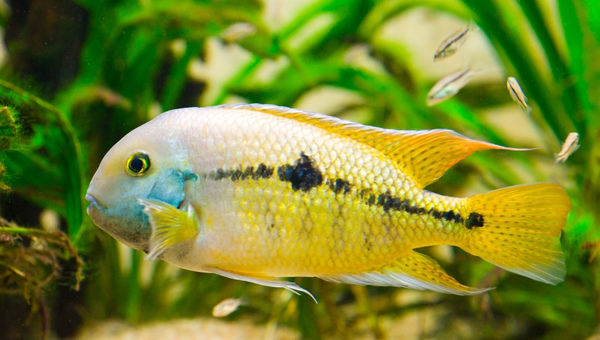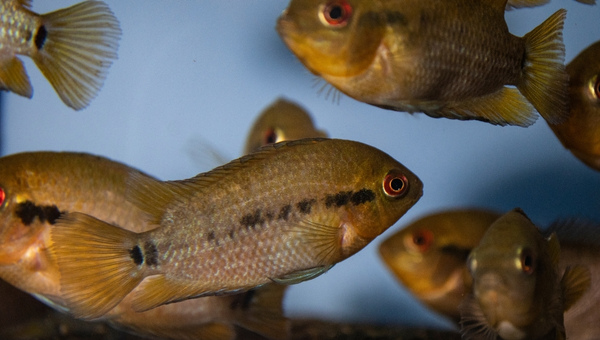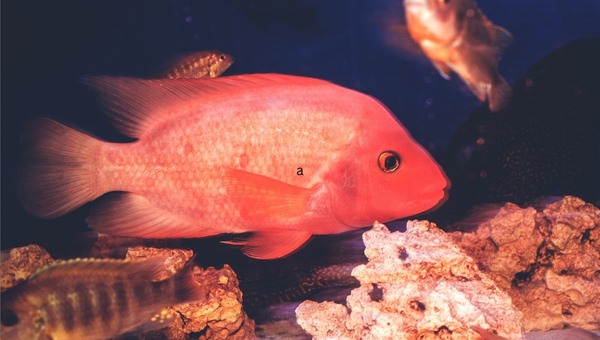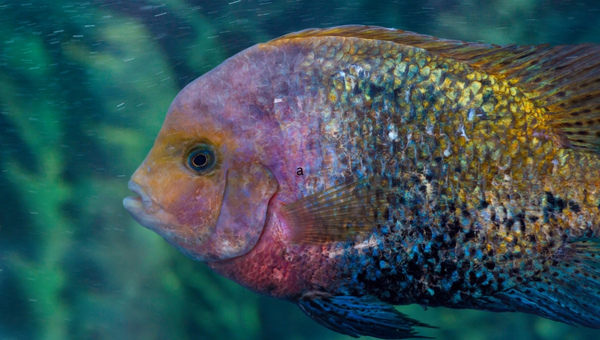The Rainbow Cichlid (Herotilapia multispinosa) is a tropical freshwater fish belonging to the cichlid family. It is native to Central America and found in Honduras, Nicaragua, and Costa Rica.
The Rainbow Cichlid is a popular aquarium fish and has been introduced to other areas, including the United States, where it is considered invasive.
They are laterally compressed fish with deep bodies and large heads. It has a long, pointed snout and small eyes. The mouth is located at the tip of the snout and contains sharp teeth. The body is covered in large, circular scales, and the dorsal and anal fins are long and pointed.
The Rainbow Cichlid is brightly colored, with a greenish-blue body and yellow spots on the head, fins, and tail. They are used in traditional medicine in Honduras, which is believed to have medicinal properties. The Rainbow Cichlid is a protected species in Nicaragua.
The Rainbow Cichlid is an omnivorous fish, feeding on algae, insects, crustaceans, and small fish.
However, providing them with plenty of hiding places is essential, as they like to retreat when stressed.
Table of Contents
Species Summary
| Scientific name: | Herotilapia multispinosa |
| Care Level: | Easy |
| Temperament: | Peaceful |
| Color: | Muddy brown, tan, yellow, and gold |
| Family: | Cichlidae |
| Lifespan: | 8-10 years |
| pH Range: | 7.0-8.0 |
| Water Hardness: | 9-20 dGH |
| Water temperature: | 70°-82°F |
| Size: | 3-5 inches |
| Diet: | Omnivore |
| Minimum Tank Size: | 20 gallons |
| Tank Setup: | Freshwater, plants, caves |
| Compatibility: | Peaceful community fish |
Rainbow Cichlid Appearance
The Rainbow Cichlid is a sexually dimorphic species, with the males being more prominent and brightly colored than the females. The male also has a longer dorsal fin and a more pointed anal fin.
The body of the Rainbow Cichlid is oval-shaped, and its coloration can range from muddy brown to tan, yellow, or gold. They have dark vertical stripes that run along their body, and their fins are edged in black.

They can change colors depending on their mood, and their colors will become more intense when spawning. They have an elongated body with pointed dorsal fins. Rainbow Cichlid living in an aquarium will grow between three and five inches long. Wild fish can grow up to seven inches long.
Male and female Rainbow Cichlids look similar, but some physical characteristics help to distinguish them. The most notable difference is size, with females growing up to one inch larger than males. Males also have longer and more pointed fins than females.
Rainbow Cichlid Size and Growth Rate
The Rainbow Cichlid is a small fish that only grows about 5 inches long. The growth rate of the Rainbow Cichlid is relatively fast, and they can reach their full size within a year or two.
Check Jaguar Cichlids Care: Appearance, Lifespan
Rainbow Cichlid Lifespan
The lifespan of the Rainbow Cichlid is 8 to 10 years on average, but they have been known to live for up to 15 years in captivity.
Rainbow Cichlid Behavior and Temperament
The Rainbow Cichlid is a peaceful fish that gets along well with other fish. They are known to be remarkably tolerant of other cichlids. However, they can be aggressive towards fish that are similar in size and appearance.

When choosing tank mates for your Rainbow Cichlid, it is essential to consider their temperament. Some good options include other cichlids, catfish, and loaches. Avoid fish that are similar in size and appearance, as they may be seen as a threat by the Rainbow Cichlid.
It is also essential to consider the size of your tank when choosing tank mates. The Rainbow Cichlid can grow quite large, so that they will need a tank of at least 20 gallons. If you have a smaller tank, it is best to stick with similar fish.
Rainbow Cichlid Breeding
The Rainbow Cichlid is a mouth-brooding fish, which means that the female will carry the eggs and fry them in her mouth until they are ready to be released. The breeding process is triggered by changes in water conditions, such as an increase in temperature or a decrease in ph.
To induce spawning, you can use a method known as the “dry start method.” This involves slowly lowering the water level in the tank over days or weeks. The fish will be forced to spawn when the water level is low enough.
Once spawning begins, the female will lay her eggs on a flat surface such as a rock or driftwood. The male will then fertilize the eggs. The female will then pick up the eggs in her mouth and carry them to a safe location.
The fry will hatch after about three days, at which point they will be free swimming. The fry is tiny and vulnerable at this stage, so it must be fed carefully. Live foods such as brine shrimp or daphnia are good options.
The fry will proliferate and be ready to move to its tank within a few weeks. At this point, you can start feeding them pellets or flakes.
Also, check Blood Parrot Cichlid Best Care Guide, Lifespan, Size & All
Rainbow Cichlid Care Guide
The Rainbow Cichlid is a peaceful fish that is easy to care for. They are tolerant of a wide range of water conditions, but providing them with plenty of hiding places is essential, as they like to retreat when they feel stressed.
They are also susceptible to Ich, so monitoring the water quality and treating the tank is essential.
When choosing tank mates for the Rainbow Cichlid, it is essential to choose peaceful fish that are similar in size. Good tank mates include other cichlids, tetras, gouramis, and danios.
Following are some tips for caring for the Rainbow Cichlid:
- Provide a tank of at least 20 gallons, with plenty of hiding places.
- Use a filter and keep the water quality high.
- Monitor the tank for Ich and treat if necessary.
- Choose peaceful fish that are similar in size to tank mates.
Rainbow Cichlid Food and Diet
The Rainbow Cichlid is an omnivore and will eat a variety of foods. They are known to be particularly fond of live foods, such as brine shrimp and bloodworms. However, they will also eat flakes, pellets, and frozen foods.
To ensure your fish are getting a balanced diet, it is essential to feed them various foods. This includes live foods, flakes, pellets, and frozen foods. A good rule of thumb is to provide your fish two to three times a day.
You may also check Firemouth Cichlid 101: Diet, Size, Care Guide & All
Following are some excellent food options for Rainbow Cichlids with their pros and cons:
Live foods
| Pros: | Cons: |
| Live foods are a good source of protein | Live foods can be expensive |
| They are high in moisture content, which is suitable for the fish | They can carry diseases |
| Live foods can help stimulate the appetite | They can be challenging to store and keep alive |
Flakes
| Pros: | Cons: |
| Flakes are a good source of protein | Some fish may not be as interested in eating flakes |
| They are easy to store and don’t require live food | Flakes can sink to the bottom of the tank, where they may not be eaten |
| Flakes are generally less expensive than live foods |
Pellets
| Pros: | Cons: |
| Pellets are a good source of protein | Some fish may not be as interested in eating pellets |
| They are easy to store and don’t require live food | Pellets can be more expensive than flakes |
| Pellets generally sink to the bottom of the tank, where Rainbow Cichlids like to eat |
Frozen foods
Frozen foods can sink to the bottom of the tank, where they may not be eaten.
As you can see, there are various food options for Rainbow Cichlids. The best diet for your fish will depend on several factors, including their individual preferences and your budget. Ultimately, the most important thing is to ensure that your fish are getting a balanced diet.
Check African Cichlid Care Guide: Diet, Tankmates, Lifespan & All
Rainbow Cichlid Tank Size
The Rainbow Cichlid is a small fish that only grows about 5 inches long. As such, they do not require a large tank. A tank of at least 20 gallons will be sufficient.
Thus, a 20-gallon tank is the recommended size for one Rainbow Cichlid. If you keep more than one, you will need a larger tank.
Rainbow Cichlid Tank Mates
The Rainbow Cichlid is a peaceful fish that can get along with most tank mates. They often live near other cichlids in the wild and do not show aggression.

You may only see an attack when two males are fighting for dominance or when a female is guarding her fry.
Some compatible tank mates for the Rainbow Cichlid include:
- Other peaceful cichlids, such as the Angelfish, Dwarf Gourami, and Pearl Gourami
- Friendly catfish such as the Corydoras Catfish and Plecostomus
- Peaceful Tetras such as the Neon Tetra and Cardinal Tetra
- And other mild community fish, such as the Guppy and Platy
When choosing tank mates for your Rainbow Cichlid, it is essential to avoid any fish that are aggressive or larger than the Rainbow Cichlid. Aggressive fish will likely bully the Rainbow Cichlid, and larger fish may see the Rainbow Cichlid as food.
Rainbow Cichlid Water Parameters
The Rainbow Cichlid is a hardy fish that can tolerate many water conditions. However, they prefer warm waters with a pH of 7.0 to 8.0 and a 70° to 82°F temperature. It is essential to maintain high water quality, as they are susceptible to Ich.
Following are some tips for maintaining the water parameters for the Rainbow Cichlid:
- Use a filter to keep the water clean.
- Perform regular water changes of at least 20%.
- Test the water regularly and make adjustments as necessary.
The water parameters that need to be followed are listed below:
- pH: 7.0-8.0
- Temperature: 70°-82°F
- Water hardness: 9-20 dGH
- Water quality: High
Filtration
The Rainbow Cichlid is a small fish that does not produce much waste. As such, they do not require a heavy filtration system. A simple filter will suffice. However, keeping the water quality high is essential, as they are susceptible to Ich.
Following are some excellent filters with their functions for the Rainbow Cichlid:
- Aquaclear 50 Power Filter: This filter is suitable for tanks up to 50 gallons and has a flow rate of 200 GPH. It comes with a media basket filled with your choice of filtration media.
- Marina Hang-On-Back Filter: This filter is suitable for tanks up to 30 gallons and has a flow rate of 160 GPH. It comes with a media basket filled with your choice of filtration media.
- Fluval C2 Power Filter: This filter is suitable for tanks up to 30 gallons and has a flow rate of 185 GPH. It comes with a media basket filled with your choice of filtration media.
Also, check Red Devil Cichlid 101: Best Detailed Care Guide
Lighting
The Rainbow Cichlid does not require special lighting. An essential fluorescent aquarium light will suffice. However, if you keep live plants in the tank, you will need stronger light. Thus, a T8 or T5 HO light would be a good choice.
Following are some excellent lights with their functions for the Rainbow Cichlid:
- Fluval Sea Marine and Reef LED Strip Light: This light is suitable for tanks up to 50 gallons and has a color temperature of 10,000K. It is perfect for reef tanks or those who want to keep live plants.
- AquaIllumination AI Prime 16HD LED Light: This light is suitable for tanks up to 65 gallons and has a color temperature of 10,000K. It is perfect for reef tanks or those who want to keep live plants.
- Finnex Planted+ 24/7 LED Aquarium Light: This light is suitable for tanks up to 75 gallons and has a color temperature of 6,500K. It is perfect for those who want to keep live plants.
Substrate
The Rainbow Cichlid does not require a particular substrate. Bare gravel or sand will suffice. However, if you keep live plants in the tank, you will need a planting substrate.
Following are some excellent substrates with their functions for the Rainbow Cichlid:
- Fluval Plant and Shrimp Stratum: This substrate is suitable for those who want to keep live plants. It is a nutrient-rich planting substrate that contains all the necessary nutrients for plant growth.
- Carib-Sea Eco-Complete Planted Aquarium Substrate: This substrate is suitable for those who want to keep live plants. It contains all the necessary nutrients for plant growth and is also rich in iron, which is beneficial for plant growth.
- Seachem Fluorite Black Sand: This substrate is suitable for those who want to keep live plants. It is a nutrient-rich planting substrate that contains all the necessary nutrients for plant growth. It is also rich in iron, which is beneficial for plant growth.
Also, check Peacock Cichlid 101: Facts, Characteristics & Care Guide
Plants
The Rainbow Cichlid does not require live plants, but they can be an excellent addition to the tank. If you add live plants, choose ones compatible with the water parameters listed above.
Following are some excellent plants for the Rainbow Cichlid:
- Anacharis
- Hornwort
- Java Fern
- Water Sprite
Ornaments
The Rainbow Cichlid does not require unique ornaments. They will do fine with bare rocks and caves. However, if you want to add some decorations to the tank, ensure they are safe for the fish and will not harm them.
Following are some excellent ornaments for the Rainbow Cichlid:
- Zoo Med Aqua Cave: This ornament is safe for the Rainbow Cichlid and is made of durable ceramic. It is also porous, which allows beneficial bacteria to grow on it.
- Penn-Plax Aquarium Decoration Rock formations: These rocks are safe for the Rainbow Cichlid and are made of non-toxic resin. They are also realistic-looking and will add a natural look to your tank.
- Exo Terra Rock Outcrop: This ornament is safe for the Rainbow Cichlid and is made of non-toxic resin. It is realistic-looking and will add a natural look to your tank.
You may also check Red Empress Cichlid 101: Best Care Guide
Water Changes
The Rainbow Cichlid is a hardy fish and can tolerate less-than-perfect water conditions. However, it is still essential to do regular water changes to keep the tank clean and the water quality high. A general rule of thumb is to do a 20% water change every two weeks.
Following are some tips for doing water changes:
- Use a gravel vacuum to remove the debris from the substrate.
- Use a siphon to remove the water from the tank.
- Refill the tank with clean, fresh water.
- Add a water conditioner to remove any harmful chemicals from the water.
Cleaning the tank
You should perform a partial water change of 20% every other week. You will also need to vacuum the gravel and clean the filter media. Rinse the filter media in old tank water to prevent disrupting the beneficial bacteria colony.
To clean the tank, you will need the following:
- A sponge: A sponge can be used to wipe down the inside of the tank.
- A toothbrush: To clean the filter, we can use a toothbrush.
- Freshwater: You will need fresh water to rinse off the sponge and toothbrush.
The steps for cleaning the tank are as follows:
- Remove the fish from the tank and put them in a temporary home.
- Remove all of the decorations from the tank.
- Use the sponge to wipe down the inside of the tank.
- Rinse the sponge and toothbrush with fresh water.
- Use the toothbrush to clean the filter.
- Rinse the sponge and toothbrush with fresh water.
- Add the decorations back to the tank.
- Add the fish back to the tank.
It is essential to clean the tank regularly to prevent the build-up of algae and bacteria. Algae and bacteria can be harmful to fish, and they can also cause the water to become cloudy.
Also, check Convict Cichlid Care: Best Detailed Guide
Cleaning The Filter
It is essential to clean your filter regularly. A dirty filter can cause problems for your fish.
To clean your filter, you will need the following:
- A clean bucket: It is used to hold the old water.
- A garden hose: To rinse the filter media, we will use a garden hose.
- Filter media: This is used to replace the old media.
To start, you will need to remove the filter from your tank. Then, use the clean bucket to hold the old water. Next, use the garden hose to rinse the filter media. Finally, replace the old media with new media.
Rainbow Cichlid Common Possible Diseases
The Rainbow Cichlid is a hardy fish and does not succumb to diseases easily. However, there are a few common diseases that can affect fish.

- Ich: Ich is a parasitic infection that causes white spots on the fish. Poor water conditions commonly cause it.
- Finrot: Finrot is a bacterial infection that causes the fins to rot. Poor water conditions commonly cause it.
- Swim bladder disease: This condition affects the swim bladder and can cause the fish to have buoyancy problems. It is commonly caused by constipation or vesicular stomatitis virus (VSV).
- Rainbow Cichlid virus (RCV): This virus affects the Rainbow Cichlid. It is commonly spread through contact with other infected fish.
- Mouth fungus: This is a fungal infection that affects the mouth. Poor water conditions commonly cause it.
To prevent diseases from occurring, it is essential to maintain good water conditions. This includes regular water changes, vacuuming the gravel, and cleaning the filter. It is also necessary to quarantine new fish before adding them to your tank.
Quarantine keeps new fish in a separate tank for some time to ensure they are not sick.
Also, check Cardinal Sulawesi Shrimp 101: Care Guide & Breeding Guide
Preventing Diseases
The best way to prevent diseases is to maintain good water conditions. This includes regular water changes, vacuuming the gravel, and cleaning the filter. It is also essential to quarantine new fish before adding them to your tank.
Quarantine keeps new fish in a separate tank for some time to ensure they are not sick.
Another way to prevent diseases is to choose fish that are less likely to get sick. This includes choosing healthy fish from a reputable source. It is also important to avoid overstocking your tank. Overstocking can lead to poor water conditions, making your fish more susceptible to diseases.
Following are a few tips for preventing diseases:
- Do regular water changes.
- Vacuum the gravel.
- Clean the filter.
- Quarantine new fish.
- Choose healthy fish from a reputable source.
- Avoid overstocking your tank.
- Maintain good water conditions.
- Keep your tank clean.
- Don’t add fish that are sick.
- If you see any signs of disease, treat it immediately.
Treatment and Medications
The Rainbow Cichlid is a hardy fish and does not require medication. However, if your fish becomes sick, a few common drugs can be used to treat them.
- Ich: Ich can be treated with erythromycin or copper sulfate.
- Finrot: Finrot can be treated with kanamycin or neomycin.
- Swim bladder disease: Swim bladder disease can be treated with metronidazole or amoxicillin.
- Mouth fungus: Mouth fungus can be treated with ketoconazole or clotrimazole.
If you think your fish is sick, you must take them to a vet for a diagnosis. Once the disease has been diagnosed, the vet will prescribe the appropriate medication.
Check Ultimate Dragon Goby 101: Care, Appearance, Food, Habitat & All
Advantages Of Having Rainbow Cichlid In Your Tank
Following are some of the benefits of having Rainbow Cichlids in your tank:
- They are beautiful fish that add color and interest to your aquarium.
- They are peaceful fish that get along well with most other tank mates.
- They are easy to care for and relatively hardy.
- They are fun to watch and interesting to observe.
Disadvantages Of Having Rainbow Cichlid In Your Tank
Following are some of the potential disadvantages of having Rainbow Cichlids in your tank:
- They can be aggressive towards other fish, especially if they are not properly socialized.
- They may dig up plants and rearrange decorations in the tank.
- They need a large tank, at least 50 gallons.
- They are not recommended for beginners due to their potential aggression.
Also, check Silver Dollar Fish 101: Care, Diet, Appearance, Breeding & All
Summary
If you have a large tank and are looking for a beautiful, peaceful fish that is easy to care for, then the Rainbow Cichlid may be a good choice. However, if you are a beginner or do not have an extensive enough tank, you should consider another fish.
Thus, if you are looking for a beautiful, easy-to-care-for, and peaceful fish, the Rainbow Cichlid may be the perfect choice for your aquarium.



